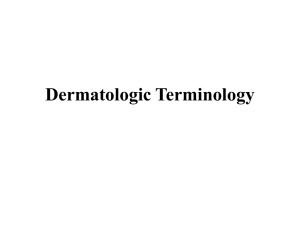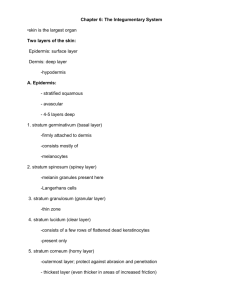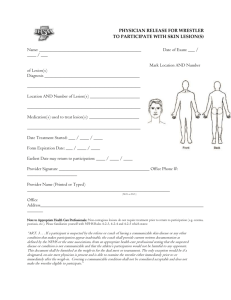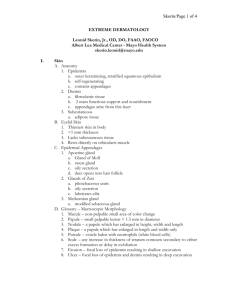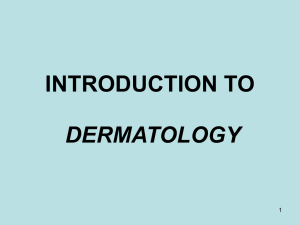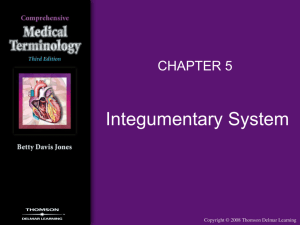review - CK Mobile Equine Services
advertisement
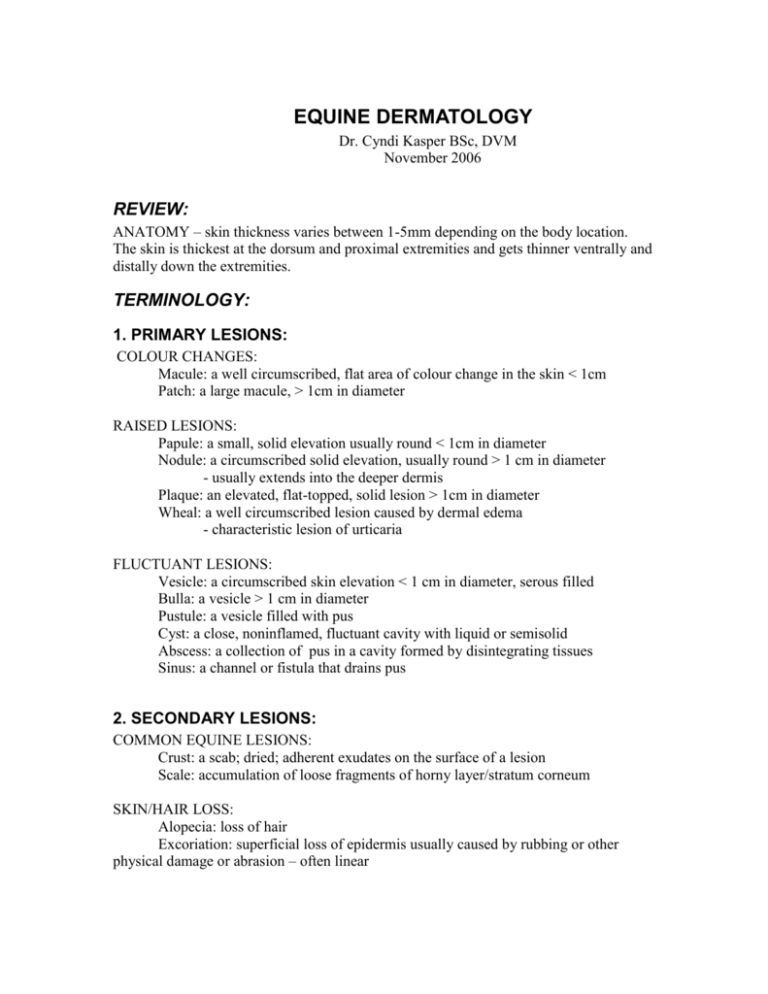
EQUINE DERMATOLOGY Dr. Cyndi Kasper BSc, DVM November 2006 REVIEW: ANATOMY – skin thickness varies between 1-5mm depending on the body location. The skin is thickest at the dorsum and proximal extremities and gets thinner ventrally and distally down the extremities. TERMINOLOGY: 1. PRIMARY LESIONS: COLOUR CHANGES: Macule: a well circumscribed, flat area of colour change in the skin < 1cm Patch: a large macule, > 1cm in diameter RAISED LESIONS: Papule: a small, solid elevation usually round < 1cm in diameter Nodule: a circumscribed solid elevation, usually round > 1 cm in diameter - usually extends into the deeper dermis Plaque: an elevated, flat-topped, solid lesion > 1cm in diameter Wheal: a well circumscribed lesion caused by dermal edema - characteristic lesion of urticaria FLUCTUANT LESIONS: Vesicle: a circumscribed skin elevation < 1 cm in diameter, serous filled Bulla: a vesicle > 1 cm in diameter Pustule: a vesicle filled with pus Cyst: a close, noninflamed, fluctuant cavity with liquid or semisolid Abscess: a collection of pus in a cavity formed by disintegrating tissues Sinus: a channel or fistula that drains pus 2. SECONDARY LESIONS: COMMON EQUINE LESIONS: Crust: a scab; dried; adherent exudates on the surface of a lesion Scale: accumulation of loose fragments of horny layer/stratum corneum SKIN/HAIR LOSS: Alopecia: loss of hair Excoriation: superficial loss of epidermis usually caused by rubbing or other physical damage or abrasion – often linear Erosion: a partial thickness loss of the epidermis that does not penetrate the basal layer and usually heals with scarring Ulcer: full thickness loss of epidermis that exposes the underlying dermis Scar: mark resulting from fibrous tissue proliferation in the healing of deep skin defects PIGMENT CHANGES: Melano: darking of skin or darking of hair Leuko: lightening of skin or hair RELATED TERMS: Epidermal Collarette: circular rim of peeling epidermis at recent erosion or ulcer Lichenification: skin thickening and hardening with exaggeration of the normal lines and markings; hallmark of chronic inflammation APPROACH TO SKIN DISEASES: HISTORY: Be Complete! Signalement: age, breed, gender, colour, use, etc Ie. Neonatal foals – congenital skin disorders Breeds – Apps with pemphigus foliaceous QH with HERDA, linear keratosis, recticulated leukotrica Arabs with vitiligo Belgians with epidermolysys bullosa Skin colour – can alert to primary skin or other problems Grey horses with meloanomas White mucocutaneous areas with SCC Lethal white syndrome Lavender foal syndrome in Egyptian arabs HEALTH/HEALTH MAINTENANCE: - ask about deworming, fly control and any other disease on the farm ENVIRONMENT: - damp environment may predispose animal ie. Rainscald recent stressor in young ie ringworm seasonal? Other horses affected New hay shipment, bedding Exposure, burnt, selenium toxicosis Fly control DIET: - bedding material-contact areas on lower limbs and belly feed positions – ground vs hay nets COMPLAINT: - determine exact nature of signs has it spread has it changed in appearance season of onset is it pruritic ****** other herd involvement – human and animal any other signs including weight loss PHYSICAL EXAMINATION 1. distant examination: - lesion distribution - hair coat quality - general habitus - condition 2. Close examination: - Try to identify primary clinical syndrome a) Scabby horse: alopecia, scaling and crusting +/- exudation +/- pruritus b) Raised lesions: papules, nodules or masses +/- ulceration c) Vesicular type: vesicles, bullae, ulcers +/- erosions d) Pigment change: ie lethal white syndrome, leukotrichia e) Swollen horse: edema, swelling +/- exudation +/- necrosis f) Miscellaneous: ie hirsutism, cutaneous asthenia – Ehler-Danlos NOTE/ pay particular attention to all mucous membranes and mucocutaneous junctions. Do not forget the cornary bands, and best to lift feet and examine the frogs. And make sure you check all lymph nodes. DIAGNOSTIC AIDS: 1. Skin scraping: - useful for demonstrating primarily microscopic ectoparasites such as mites and lics - is still routinely performed; not a rewarding aid - scrape multiple active and recent lesions - sites should be clipped to short stubble prior to scraping - can apply mineral oil to area - need both superficial and deep scrapings - for best results; squeeze hair follicles and then scrape until capillary bleed - place sample on slide and immerse in mineral oil 2. Dermatophyte culture: - any horse with focal or generalized alopecia should be tested - pluck scales, crust and broken hair from periphery of lesions and press onto medium - best to initially wipe gently with alcohol and allow to dry - medium is Saabouraud’s dextrose agar - dermatophytes present as beige fluffly colonies in 5-7 days - will also turn agar pH indicator red - saprophytes are grey-green and will also turn indicator red – takes 7 days NOTE/most equine dermatophytes grow at room temperature. It is essential to check cultures on a daily basis to determine if colony growth and colour change occurs at the same time. Important to incubate for three weeks before a negative culture is declared. 3. Potassium hydroxide preparations: - not a sensitive test; can have many false positives and false negatives - can be a potential for an immediate diagnosis of dermatophytes - expertise require to interpret results - hair and crusts collected from periphery of lesion; add a drop of 10-15% KOH – this will dissolve the keratin and bleach the melanin in the hair shafts - this is then scanned for presence of hyphae or arthrocondia - as not a good test for sensitivity and specificity; should culture all cases 4. Acetate (Scotch) tape preparations: - primarily used to diagnose Oxyuris equi as cause of alopecial in tailhead region - press piece of tape several times in area - place piece of tape on slide with mineral oil - can also use to diagnose Chorioptes spp – may lightly clip area 5. Dermatophilus preparation: - impression smear of the underside of the crusty lesion on a slide stained with diff quick or giemsa to check for bacteria - rain scald or Dermatophilus congolensis are branch-like filamentous bacteria that divide horizontally and longitudinally aka railroad tracks. - if negative; should also culture 6. Biopsy: - always ensure tetanus vaccination is up to date before proceeding - do not surgically prep area as will remove crust and epithelia tissue - do not infiltrate with local anesthetic - ideally do in three places including normal skin - Techniques include: - excisional: removing entire lesion; ideal for nodular lesions esp sarcoids - wedge: if mass is too large to remove - elliptical: preferred for vesicular, bullous and ulcerous lesions - punch: most common; ~6-8 mm punch biopsy; not for flat sarcoids - shave: UK variant - for histopath – place in 10% formalin - make sure immune mediated disorders have been off steroids for 3 weeks - be careful if biopsy flat or occult sarcoid because the lesdion may develop into a wartyverrucous or fibroblastic lesion 6. Onchocerca preparation: - horses with lesions of alopecia, scaling and crusting of ventral midline, proximal forelimbs, neck and forehead - with biopsy punch – mince portion with scalpel on a slide; add saline; and incubate for 15 minutes at room temperature - scan slide for whiplash appearance of microfilaria - if negative, add water to Petri dish, suspend slide over and cover – incubate for several hours and re-examine NOTE/ a normal horse can have a positive onchocerca prep 7. Bacterial culture: - shave and wash with antiseptic soap; dry with sterile gause and biopsy with a sterile technique - pyodermas are rare 8. Cytological examination: - ideal for intact vesicle or pustules: caution with flat sarcoids -ie. Needle aspirates, tissue imprints, tissue scrapings and exudates smears 9. Miscellaneous: - intradermal skin testing, in vitro allergy testing, LE preps, ANA testing

